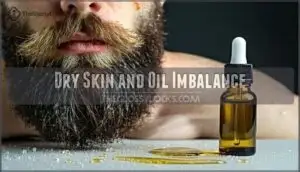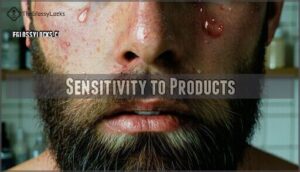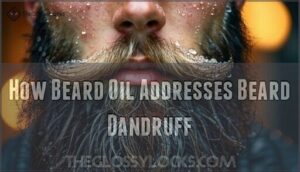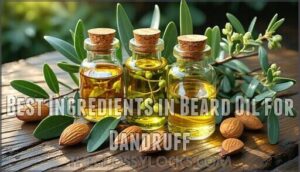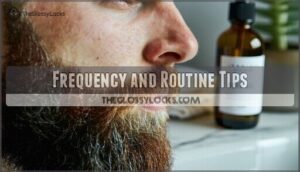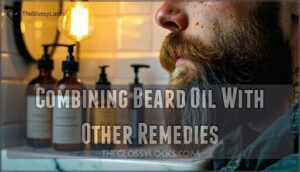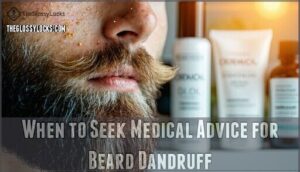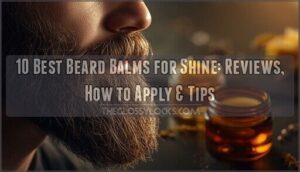This site is supported by our readers. We may earn a commission, at no cost to you, if you purchase through links.
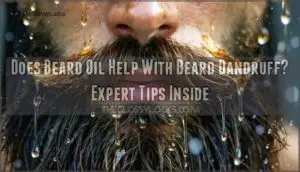
Carrier oils like jojoba and argan mimic your skin’s natural sebum, while tea tree oil packs an antifungal punch that can reduce flakes by up to 88%. Apply 3-4 drops to clean facial hair and massage thoroughly into both beard and skin underneath. The secret lies in choosing the right ingredients and proper application technique.
Table Of Contents
- Key Takeaways
- Does Beard Oil Help With Beard Dandruff?
- What Causes Beard Dandruff?
- How Beard Oil Addresses Beard Dandruff
- Best Ingredients in Beard Oil for Dandruff
- How to Use Beard Oil for Dandruff Relief
- Combining Beard Oil With Other Remedies
- When to Seek Medical Advice for Beard Dandruff
- Frequently Asked Questions (FAQs)
- How do I get rid of beard dandruff?
- Does Beard oil help dandruff?
- Does a facial moisturizer cut beard dandruff?
- Does beard balm get rid of dandruff?
- Does beard oil help with dandruff?
- How do I stop dandruff in my beard?
- How do you treat anti dandruff in your beard?
- Does a beard brush help with dandruff?
- How often should beard oil be applied?
- Can beard oil clog facial pores?
- Conclusion
Key Takeaways
- You’ll find beard oil tackles dandruff by moisturizing the dry skin beneath your whiskers and restoring your natural oil balance, which prevents flakes from forming.
- You should look for oils containing jojoba, argan, and tea tree ingredients – these mimic your skin’s natural sebum while fighting the fungus that causes seborrheic dermatitis.
- You’ll get the best results by applying 3-4 drops daily to clean facial hair, massaging thoroughly into both beard and underlying skin using circular motions.
- You can boost effectiveness by combining beard oil with gentle exfoliation 2-3 times weekly and using sulfate-free beard washes that won’t strip your natural oils.
Does Beard Oil Help With Beard Dandruff?
Yes, beard oil can substantially help with beard dandruff by tackling its root causes. This powerhouse product delivers targeted skin hydration that prevents the dry conditions where dandruff thrives.
Quality beard oils contain carrier oils like jojoba and argan that mimic your skin’s natural sebum, restoring moisture balance beneath your facial hair. Many formulas include tea tree oil, which fights Malassezia globosa—the fungus responsible for seborrheic dermatitis.
Regular use as part of proper beard maintenance creates an environment where flakes can’t flourish, making beard oil an effective dandruff treatment.
What Causes Beard Dandruff?
Your beard dandruff stems from three main culprits that disrupt your skin’s natural balance.
Dry skin creates flaky conditions, while Malassezia fungus feeds on facial oils and triggers inflammation.
Harsh grooming products can irritate sensitive skin beneath your beard.
Dry Skin and Oil Imbalance
Your skin’s moisture barrier acts like a protective shield, but when it’s compromised, beard dandruff strikes back. Dry skin causes disrupted oil balance and altered skin pH levels, creating the perfect storm for flaking.
Cold weather strips natural oils, while overwashing removes essential moisture locking properties.
Beard oil helps restore this delicate balance through natural remedies that replenish lost hydration and normalize sebum production underneath your facial hair.
Seborrheic Dermatitis and Fungal Growth
Beyond dry skin lies a more complex culprit: seborrheic dermatitis. This condition occurs when Malassezia fungus feeds on your skin’s natural oils, producing irritating compounds that trigger flaky skin and beard itch. The fungal growth creates an inflammatory response, causing faster skin cell turnover and those telltale white flakes.
Fungal infections thrive in oily areas like your beard, making scalp health principles apply here too. Understanding the role of seborrheic dermatitis is vital in addressing beard dandruff effectively. Beard oil can help by starving these microbes of excess sebum.
Sensitivity to Products
Sometimes your facial skin rebels against beard care products, triggering contact dermatitis that mimics beard dandruff. Product allergens in fragrances, preservatives, and harsh chemicals can cause allergic reactions on sensitive facial skin.
Irritant identification through patch testing helps pinpoint ingredient sensitivity before it worsens skin conditions. Even quality beard oil can backfire if you’re allergic to specific components, making proper beard care feel impossible.
How Beard Oil Addresses Beard Dandruff
You’re probably wondering if beard oil can tackle those annoying white flakes that make your facial hair look like you’ve been caught in a snowstorm.
The answer is yes – beard oil works by hydrating the dry skin beneath your beard and creating a protective barrier that prevents dead skin cells from building up and flaking off.
Moisturizing Dry Skin
Beard oil addresses dry skin causes head-on by delivering targeted skin hydration where you need it most. When cold weather or harsh facial care products strip away natural moisture, your skin fights back with flakes.
Quality beard oil restores beard moisture through natural remedies like aloe vera and carrier oils. This direct approach to dry skin makes beard oil an effective weapon against beard dandruff, soothing irritated areas beneath your beard.
Restoring Skin Barrier
Your skin’s protective barrier takes a beating from environmental stressors and harsh products. Beard Oil works like a shield, using Natural Moisturizers such as jojoba and argan oils to rebuild this defense system.
These oils mimic your natural sebum, helping restore Oil Balance and strengthen Facial Health. When your barrier functions properly, it prevents Seborrheic Dermatitis and other Skin Conditions that trigger Beard Dandruff, creating ideal conditions for healthy Beard Care through improved Skin Hydration and Barrier Repair.
Reducing Flakes and Irritation
Consistency becomes your ally when tackling those stubborn white flakes. Quality beard oil creates a protective shield that calms inflamed skin while targeting the root causes of seborrheic dermatitis.
Here’s how proper beard care delivers irritation relief:
- Gentle exfoliation – Oil softens dead skin cells for easier removal during beard hygiene routines
- Anti-inflammatory action – Natural ingredients soothe redness and reduce itching sensations
- Moisture barrier restoration – Prevents future flake formation through improved dandruff treatment protocols
Regular application transforms your beard health journey.
Best Ingredients in Beard Oil for Dandruff
When you’re choosing a beard oil to combat dandruff, you’ll want to look for specific ingredients that target both dryness and fungal overgrowth. Carrier oils like jojoba, argan, and sweet almond work best because they closely mimic your skin’s natural sebum.
Essential oils such as tea tree provide antifungal properties that clinical studies show can reduce flakes by up to 88%.
Clinical studies show tea tree oil’s antifungal properties can reduce beard flakes by up to 88%
Jojoba, Argan, and Sweet Almond Oils
These carrier oils work like nature’s moisturizers for your beard and skin. Each oil mimics your skin’s natural sebum, making them perfect natural remedies for beard dandruff treatment.
| Oil Type | Key Beard Oil Benefits |
|---|---|
| Jojoba Oil | Lightweight, non-comedogenic, balances oil production |
| Argan Oil | Rich in vitamin E, repairs damaged skin barrier |
| Sweet Almond Oil | Deep moisturizing, soothes irritated skin |
| All Three | Boost Beard Hydration without clogging pores |
| Combined Use | Support thorough Beard Care Routine for all Skin Types |
You’ll find these carrier oils absorb quickly, delivering oil benefits directly to follicles and underlying skin.
Tea Tree and Other Essential Oils
Essential Oil Blends pack a powerful punch against beard dandruff. Tea tree oil leads the charge with its Natural Antifungals properties, reducing Seborrheic dermatitis severity by 41% in clinical studies. These Tea Tree Benefits include targeting malassezia fungus while soothing irritated skin.
Lavender and peppermint oils offer Aromatherapy Effects that calm inflammation. When combined with proper Oil Carrier Types in your Beard Care Routine, these essential oils transform ordinary beard oil into an effective dandruff treatment powerhouse.
Using the right beard care products can make a significant difference in maintaining a healthy beard.
Avoiding Harsh Chemicals
Chemical-free beard oil protects your beard health by avoiding ingredients that worsen seborrheic dermatitis and beard dandruff. Your skin protection depends on choosing natural ingredients over harsh synthetic compounds that strip essential oils.
Key chemicals to avoid:
- Sulfates – Strip natural oils and trigger irritation
- Synthetic fragrances – Common allergens causing contact dermatitis
- Parabens – Disrupt skin barrier function and moisture balance
Gentle cleansers and dandruff treatment options work better when your beard care routine emphasizes natural ingredients.
How to Use Beard Oil for Dandruff Relief
You’ll get the best results by applying beard oil to clean, dry facial hair after washing with a gentle beard cleanser.
Start with 3-4 drops, warm the oil between your palms, and massage it thoroughly into both your beard hair and the skin underneath using circular motions to promote proper absorption and target dandruff at its source.
Applying to a Clean Beard
First, start with clean Beard Preparation using a quality Beard and Face Wash to remove dirt and excess oils. Proper Skin Cleansing creates the foundation for ideal Oil Absorption.
Clean skin allows Beard Oils to penetrate effectively, targeting Beard Dandruff at its source. Good Beard Hygiene ensures your beard oil works efficiently rather than sitting on dirty surfaces.
Always towel-dry gently before applying any beard care products for maximum effectiveness.
Massage Techniques for Absorption
Proper massage strokes facilitate better skin absorption and oil penetration for beard grooming success. Using gentle circular motions with your fingertips, work the beard oil into your facial skin underneath the whiskers.
This facial massage technique promotes blood circulation while allowing your skin to absorb nutrients that combat beard dandruff effectively.
Frequency and Routine Tips
Ideal results come when you apply beard oil consistently. Apply once daily, ideally after washing your beard when pores are open.
Here’s your winning routine:
- Start fresh – Wash your beard 2-3 times weekly to prevent buildup
- Be consistent – Daily application creates healthier skin beneath your whiskers
- Listen to your skin – Increase frequency during dry winter months
Remember: routine maintenance beats random applications every time for conquering beard dandruff.
Combining Beard Oil With Other Remedies
You’ll get the best results when you combine beard oil with other proven treatments for maximum flake control.
Pairing regular exfoliation, gentle beard washes, and healthy lifestyle habits creates a thorough approach that targets beard dandruff from multiple angles.
Exfoliation and Brushing
Exfoliation works hand-in-hand with beard oil to combat beard dandruff effectively. You’ll want to brush your beard 2-3 times weekly using gentle cleansing motions that remove dead skin cells. This facial massage technique enhances your skin’s ability to absorb beard oil while preventing dry skin buildup.
| Technique | Frequency | Benefit |
|---|---|---|
| Beard brushing | Daily | Distributes oils evenly |
| Skin scrubbing | 2-3x weekly | Removes dead cells |
| Facial massage | With each oil application | Boosts circulation |
Using Beard Washes and Balms
Beard washes and balms work as powerful teammates alongside your beard oil routine. Quality beard wash removes buildup without stripping natural oils, while beard balm provides lasting moisture and styling control.
- Choose sulfate-free beard wash with antifungal ingredients like tea tree oil
- Apply beard balm after oil to lock in hydration and nutrients
- Look for balm ingredients like shea butter and beeswax for maximum skin protection
Lifestyle and Diet Considerations
Your inner health directly impacts beard dandruff. Anti-inflammatory dietary changes can reduce refined carbohydrates that feed yeast growth, while stress management helps prevent flare-ups.
Quality sleep patterns support skin health, and proper hydration tips include drinking water regularly. Nutrient balance from wholesome foods creates healthy beard tips that complement your oil routine for better skin health.
When to Seek Medical Advice for Beard Dandruff
You should contact a dermatologist if your beard dandruff persists for more than six weeks despite consistent treatment with beard oils and gentle cleansing routines.
Severe symptoms like intense redness, thick crusting, spreading to other facial areas, or signs of infection require professional medical evaluation.
Signs of Severe or Persistent Symptoms
Warning signs shouldn’t be ignored when beard dandruff becomes more than just minor flakes. You’ll know it’s time to seek professional help when symptoms escalate beyond typical beardruff. Severe flaking that resembles thick flake clusters, persistent itchy skin that disrupts daily activities, or red irritation spreading beyond your beard area all signal potential complications.
Watch for these concerning symptoms:
- Painful skin infections with pus or open wounds
- Thick yellow or green discharge indicating bacterial growth
- Seborrheic dermatitis spreading to eyebrows, scalp, or chest
- Malassezia overgrowth causing severe inflammation despite using dandruff shampoo with selenium sulfide
These symptoms often indicate underlying conditions requiring medical intervention rather than simple over-the-counter solutions.
Medicated Treatments and Dermatologist Help
When home remedies can’t crack the code, your doctor becomes your beard’s best friend. Dermatologist advice becomes invaluable when you’re dealing with persistent fungal infections and severe skin irritations.
They’ll prescribe medicated shampoos containing powerhouse ingredients like ketoconazole, selenium sulfide, or pyrithione zinc. These antifungal treatments target the root cause of seborrheic dermatitis, not just the surface symptoms.
Your doctor might recommend prescription-strength dandruff shampoo that packs more punch than over-the-counter options. Don’t tough it out alone—professional help can save your sanity and your skin.
Frequently Asked Questions (FAQs)
How do I get rid of beard dandruff?
Those pesky white flakes aren’t just embarrassing—they’re beatable.
Exfoliate 2-3 times weekly, use gentle beard cleansers, moisturize with quality beard oil, and consider anti-dandruff shampoos containing ketoconazole for persistent cases.
Does Beard oil help dandruff?
Yes, beard oil helps combat dandruff by moisturizing the underlying skin and hair. Dry skin can be behind a lot of beard dandruff cases, so quality oils containing jojoba or argan restore moisture balance effectively.
Does a facial moisturizer cut beard dandruff?
Like knights of old wielding polished shields, you’ll find facial moisturizer can indeed reduce beard dandruff by hydrating the underlying skin and preventing the dryness that causes flakes.
Does beard balm get rid of dandruff?
Beard balm can help reduce dandruff by moisturizing dry skin underneath your beard. The waxes and oils condition both hair and skin, while ingredients like tea tree oil provide antifungal benefits that target dandruff-causing microbes.
Does beard oil help with dandruff?
Absolutely, you’ll find that beard oil addresses dandruff by moisturizing dry skin underneath your whiskers. The carrier oils restore your skin’s natural barrier while antifungal essential oils combat the microbes causing those annoying flakes.
How do I stop dandruff in my beard?
Fighting flaky frustration starts with consistent cleansing and moisturizing. Use gentle beard shampoo twice weekly, apply beard oil daily, exfoliate regularly, and moisturize underlying skin to eliminate those pesky white flakes effectively.
How do you treat anti dandruff in your beard?
You’ll want to use specialized anti-dandruff shampoos containing ketoconazole or zinc pyrithione. Look for one that contains the active ingredient 1% ketoconazole and apply it directly to your skin underneath the beard 2-3 times weekly for best results.
Does a beard brush help with dandruff?
Like a natural exfoliant wrapped in whiskers, a beard brush gently scrubs away dead skin cells that create flakes. Regular brushing removes buildup and distributes oils evenly.
How often should beard oil be applied?
Apply beard oil daily for best results. Most men benefit from once-a-day application, though longer beards may need morning and evening use. Adjust frequency based on your skin’s response.
Can beard oil clog facial pores?
Roughly 30% of men experience clogged pores from beard products.
Quality beard oils won’t clog your pores if they’re non-comedogenic with lightweight carrier oils like jojoba or argan that mimic natural sebum production.
Conclusion
Think of your beard as a garden that needs the right nutrients to flourish. Absolutely, does beard oil help with beard dandruff by providing essential hydration and fighting fungal causes.
Quality oils with jojoba, argan, and tea tree ingredients target dry skin while restoring your natural barrier. Apply consistently, massage thoroughly, and you’ll see fewer flakes within weeks. Your beard deserves this simple yet effective solution.
- https://www.dailygrindbc.com/blogs/the-fearless-beardsman/benefits-of-beard-oil
- https://www.ncbi.nlm.nih.gov/books/NBK551707/
- https://jamanetwork.com/journals/jamadermatology/fullarticle/2820685
- https://pmc.ncbi.nlm.nih.gov/articles/PMC4852869/
- https://www.menshealth.com/grooming/a44752764/how-to-get-rid-of-beard-dandruff/

